List of 10 amazing and groundbreaking photos in the history of the world. The most viewed, moving and most important photos of mankind. Photos that changed the world.
List of 10 landmark photos of humanity
Each photo carries a message. She captures the image, preserves the fleeting moment. Some of them stand out from the rest, convey such a strong message that they move entire societies and set new boundaries. They permanently subscribe to the collective consciousness. There is no rule among them. They can be taken by professional photographers or amateurs. Taken on the spur of the moment or carefully planned.
In my letter, I have compiled 10 amazing and groundbreaking photos of humanity that I personally consider important. I thought about the selection of photos for a long time in order to select 10 out of many important historical images. It was not an easy task. I tried to choose the photos so that each of them showed a breakthrough point. Each of them should also represent a different theme. I did not want to post, for example, photos of war photos. The list of 10 groundbreaking photos is my subjective compilation. It is listed in chronological order, from oldest to newest.
1. The view from the window in Le Gras
The list of breakthrough photos opens with the oldest surviving photograph known to mankind. It was made in 1826 or 1827 by the French inventor Joseph Nicéphore Niépce. The photography was created in a rather unusual way for today's times. Well, the French inventor experimented with various forms of preserving the image that we see with the naked eye. At first he tried to record the image on paper, but this one was too fragile. In the end, Le Gras used a metal plate covered with Syrian asphalt to make the view from the window. He exposed the prepared plate to sunlight from his window. The asphalt hardened under the influence of light, and it was possible to wash it off from less exposed areas. This is how Niépce obtained the painting from his window in his family estate Le Gras in France. It is estimated that the plate had to be exposed to light for several or several hours. What I present below is a reproduction of a CD that is currently held at the University of Texas at Austin. In the foreground, we can probably see a dovecote, and a tree on its left side is located right next to it. In the left part of the photo we can also see a building.
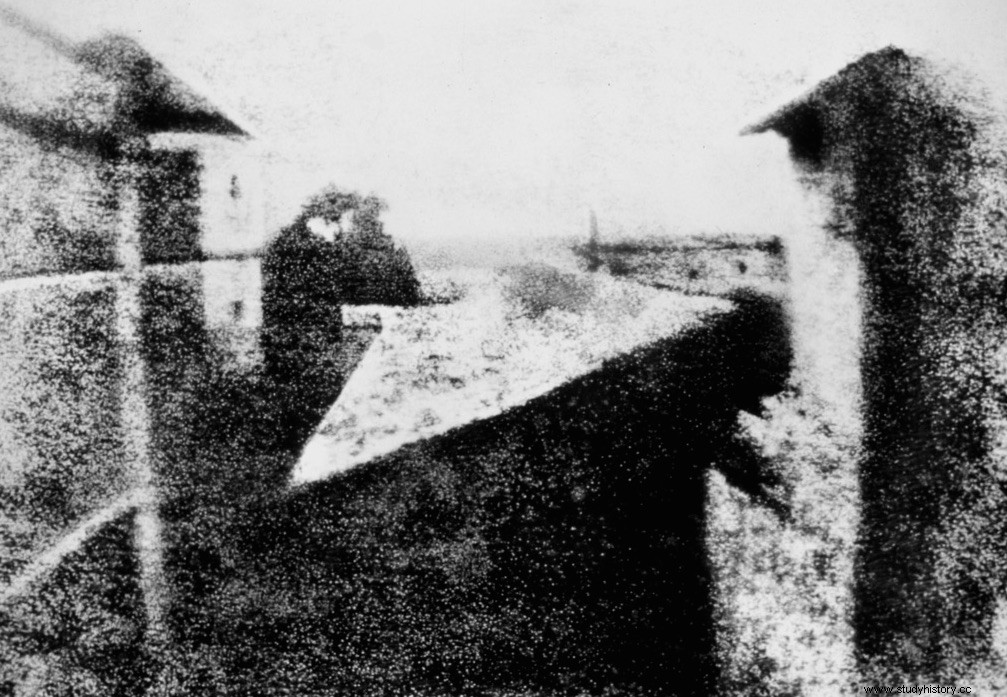
The view from the window in Le Gras - 10 landmark photos - Author:J. N. Niépce
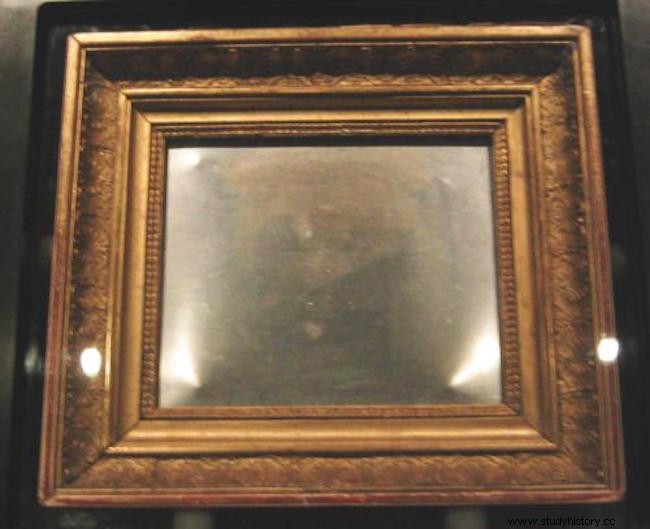
The view from the window in Le Gras - Current CD status
2. Boulevard du Temple
Niépce's method was improved after his death by his associate Louis Jacques Daguerre. It was named Daguerreotype after his surname. The creation process was much more advanced. The photograph was taken on a copper plate coated with silver iodide. The exposure time has also been shortened. We owe this method to another of the groundbreaking photos, which are attached below. This is one of the oldest daguerreotypes. It depicts the French Boulevard du Temple in Paris. The photograph was taken in 1838. As the plate's exposure time was long, the usually busy street in the photo looks deserted. In those days it was a popular and fashionable place, often used for walks. The street seems empty except for one faint figure of a man who has probably stopped to adjust his shoes. It stood long enough that it was possible to capture its character in a historical photo. Thus, the first and oldest human photography known to us was created. Soon the world went crazy about this method. There was even talk of daguerreotype. However, despite the great interest, it was later superseded by more modern technologies.
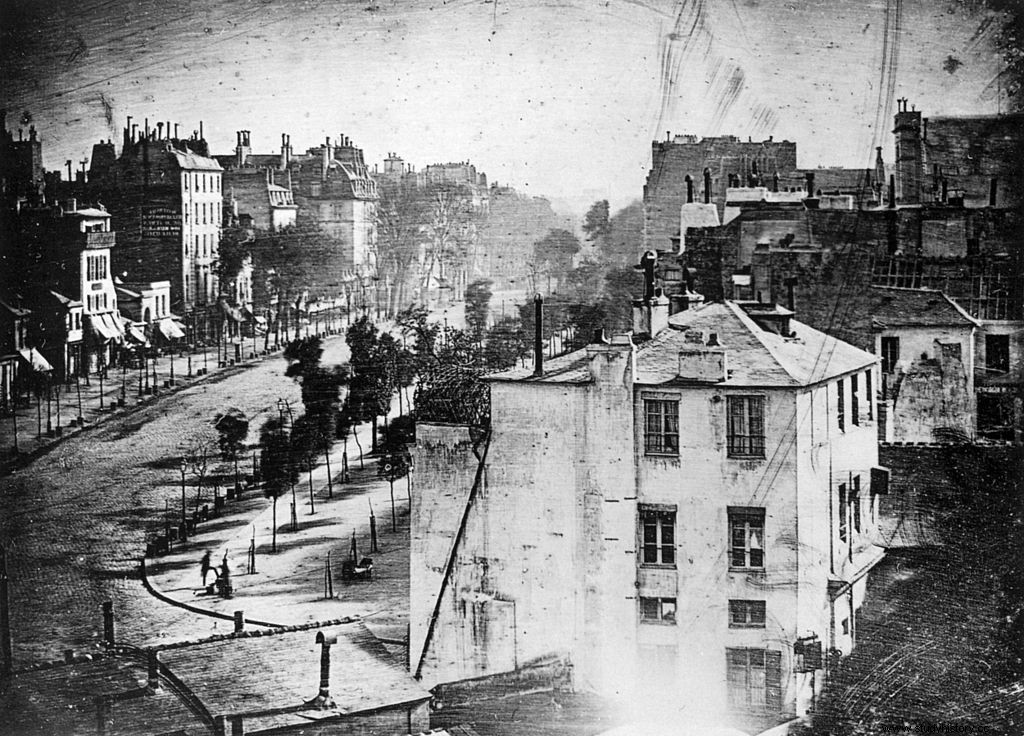
Boulevard du Temple - 10 landmark photos - Author:Louis Daguerre
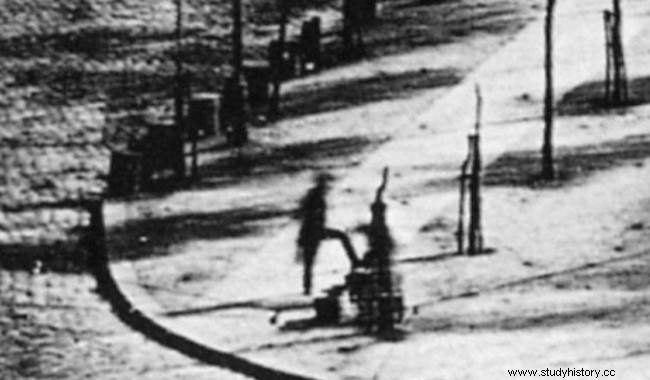
First and oldest known human photo
3. First flight of the plane
If someone asked me what invention of the 20th century I consider to be the most important, I would consider between a computer and an airplane. The invention of the plane changed our world dramatically. The possibilities offered by the plane had a colossal impact on the conduct of wars. Aviation has influenced the way we travel, changing the perspective with which we view the world today. It has simply become smaller, faster, more dynamic and better achievable for the common man. And most of all, building an airplane begins the journey towards manned spaceflight and lunar landing. Although humanity had the opportunity to fly a balloon before and saw Otto Lilienthal's first clumsy attempts, the independent flight of a structure heavier than the air was something else. It meant that man, through the machine, could fully control him. The possibility of flight was the embodiment of the age-old dreams of taking to the air. She was nothing but a divine attribute unattainable. The photo I present below was taken during the first successful flight of the Wright brothers. On December 17, 1903 at 10:35. The flight took place on Kitty Hawk beach, lasted 12 seconds, and during it the plane covered a distance of 37 m. In the photo, Orville is at the controls of the machine, assisted by Wilbur. Although there were many other designers and flight tests at that time, this flight is considered to be the first successful one. Interestingly, the length of the first flight was shorter than today's Jumbo Jet's wingspan. The author of the photo was amateur photographer John T. Daniels.
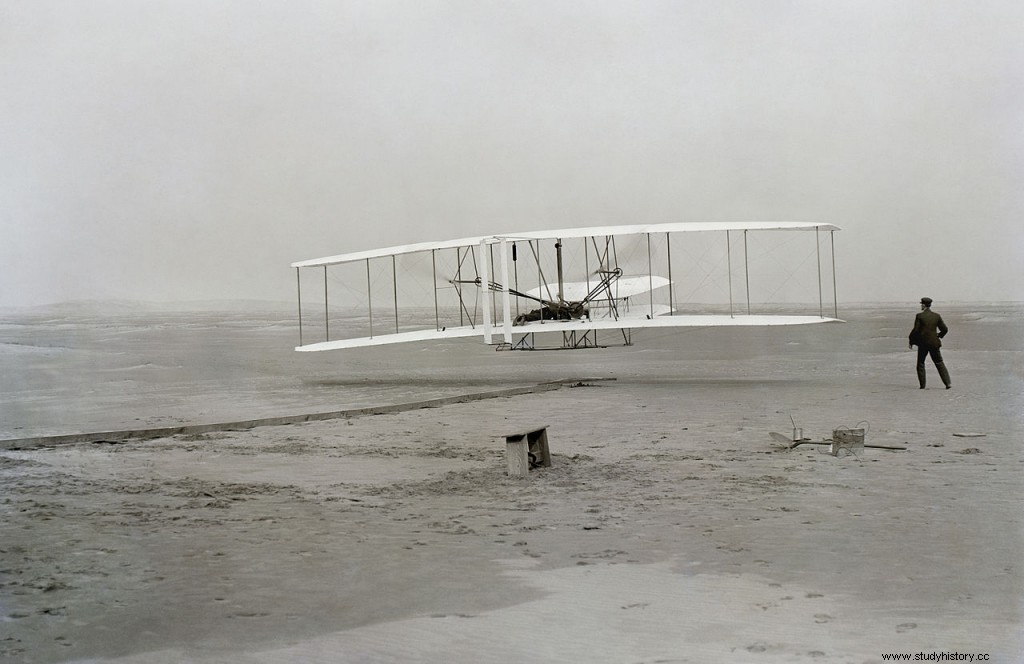
First flight of the plane - 10 landmark photos - Author:John T. Daniels
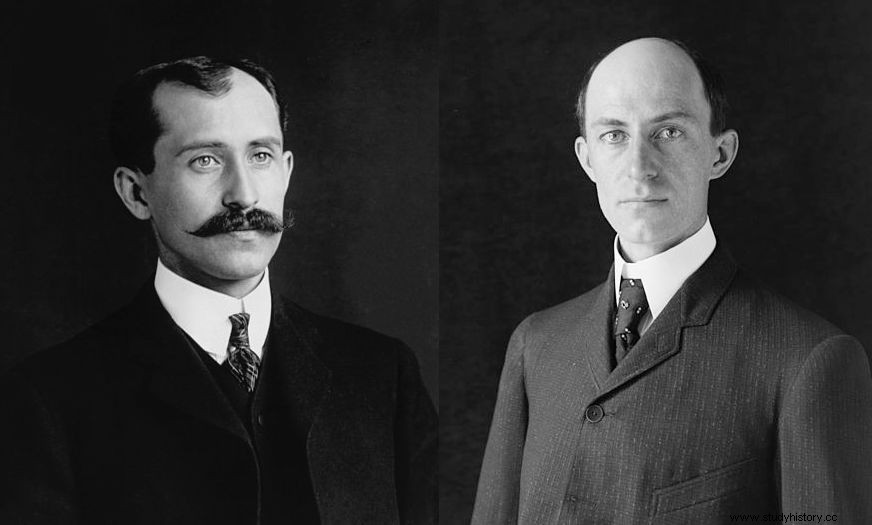
The Orville brothers and Wilbur Wright
4. Hanging the flag on Iwo Jima
How much confusing and multi-threaded story can be hidden behind one photo? It turns out enough to become even the basis for a movie script. The photo of the banner placed by six Marines on Mount Suribachi has become a symbol of victory, glory and bravery for American soldiers. At the same time, the defeat of imperialist Japan. The photo was taken by Joe Rosenthal on February 23, 1945, during the fights for the Pacific island of Iwo Jima. After photography came to America, great potential was noticed in it. So it quickly fell into the cogs of the American propaganda machine. Repeatedly published and distributed in newspapers, it has become one of the most recognizable images of the war. Only three of the six soldiers hanging the banner survived the battle. Because the fight for the island lasted another month, and the very suspension of the banner was only symbolic. Contrary to the fact that the photo's message suggests the end of the battle for Iwo Jimi. So these living soldiers were brought to the country as heroes. But the real idea was to use them to advertise war bonds. There were also allegations that the photo was not taken during the fights, but staged. In fact, the photo showed the placement of a second flag on top of Suribachi. The first flag was flown the same morning, but someone didn't like its size. So a second group of soldiers was sent to replace the flags. Then this famous photo was taken. In addition, when identifying the people in the photo, one of the soldiers was mistaken. Even though one of the surviving heroes of Ira Hayes reported a bug, the US Marines high command was reluctant to correct it. Claiming that information on the names of the heroes from Iwo Jima has already been published. With the passage of time, the photo acquired an additional symbol. A symbol of propaganda, financial arrangements, military bureaucracy, and even racial prejudice because Ira Hayes was of Indian origin. The whole confusing story is shown in the movie "Banner of Glory" directed by Clint Eastwood. The photo of Joe Rosenthal is one of the breakthrough photos in history that has become a permanent element of the social consciousness. Rosenthal received the Pulitzer Prize for his photo, though he almost missed the flag and took the photo at the last minute without even looking through the viewfinder.
Since the photo is still copyrighted, I cannot blog it. I am attaching a link.
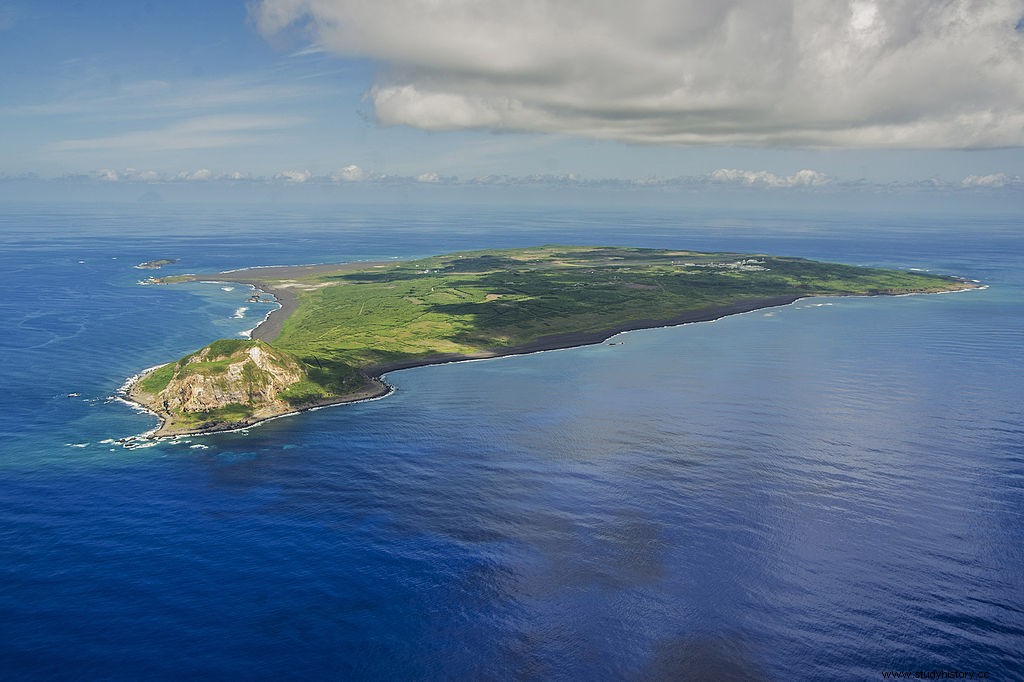
Iwo Jima Island - Suribachi Mountain below - Author:U.S. Navy Source:commons.wikimedia.org
5. Execution of a Vietcong soldier
The twentieth century will go down in human history as a time of cruel wars and extraordinary technological progress. During the period of various armed conflicts, many photographs were taken depicting images of the war. It is very difficult to say which photo would be the most symbolic, the most important one. Undoubtedly, one of them is the image of the execution of a Vietcong member. The photo was taken on January 1, 1968 in the streets of Saigon by Eddie Adams. The photographer took his famous photo literally in a split second. When Eddie Adams was about to take a picture of the escorted prisoner, he did not know that almost simultaneously with pressing the shutter button, he would be pressing the trigger of the gun. He was also unaware of the importance of photography. Death, like many others he has seen in various wars. After the photo was published, it quickly became a tool of internal political struggle in the United States. She was a symbol of the cruel war in which America was involved. A war that claimed more and more lives. In the photo, in the first moment we see a soldier shooting a man in the street, wearing a checked shirt. Killer and victim. However, nothing is black and white in war. That soldier is Chief of Police General Nguyen Ngoc Loan. He shoots a member of Vietcong who was caught while conducting diversionary activities in Saigon. All this happened on the new year during the so-called Tet offensive. During the offensive, the communists broke the ceasefire while using the holiday season as a surprise factor. Eddie Adams won the Pulitzer Prize for his photo.
Since the photo is still copyrighted, I cannot blog it. I am attaching a link.
6. Abbey Road
The sight of the Beatles passing along the stripes is one of the most replicated and groundbreaking photos of pop culture. The photo of artists marching across the street was taken on August 8, 1968, and then appeared on the cover of the album "Abbey Road". The scene of the passing Beatles was arranged during the break in the recording. We see four musicians walking down the lanes of Abbey Road in London. The name of the album was also borrowed from the street name. The almost legendary photo of the album cover aroused great interest. She became a sign of the huge popularity of the band. A symbol of the times of mass media stars and their die-hard fans. In the photo, apart from the Beatles, on the right we can also see the figure of a man standing on the pavement. This is the American tourist Paul Cole, who happened to be there by accident. At the time of taking the picture, he did not meet the musicians. On the left we see a parked Volkswagen Beetle. The huge impact of photography, through the popularity of the Beatles, is evidenced by the fact that this Beetle's license plates were soon stolen. And the car itself was auctioned after many years and went to the Volkswagen museum in Germany. The photographs also looked for hidden meanings, symbols and conspiracy theories related to the alleged death of Paul McCartney. The image of passing musicians has been recreated many times, and its theme is used in pop culture. The street itself has also become a tourist attraction and a place eagerly visited by Beatles fans.
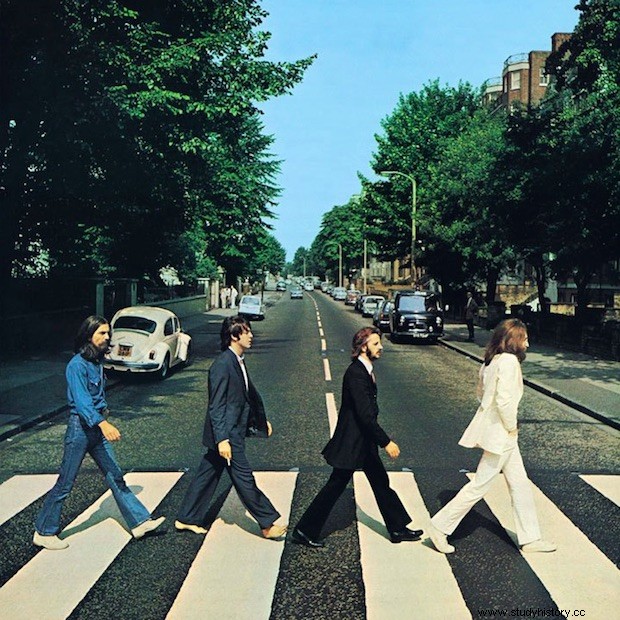
Abbey Road - 10 landmark photos - Author:Iain Macmillan Source:CD cover
7. Blue Marble
The first photo showing the globe in its entirety and fully illuminated. It was taken on December 7, 1971, by the crew of the Apollo 17 mission. The image of the Earth was captured at a distance of 29,000 km. The name Blue Marble literally means blue marble, and it owes its origin to a children's toy, glass balls called marbles. Such were the associations evoked by the view of the Earth, for the Apollo crew. This photo is a timeless image of a lonely blue planet in a huge, empty, cool and black space. The photo is awe-inspiring to our planet, but at the same time it is somewhat disturbing… Here we are. Here is our whole world, amidst immeasurable cosmic emptiness. We can only live here. Blue Marble is a groundbreaking photo and a symbol of tremendous progress. Progress of humanity that has managed to build a device capable of leaving our environment and looking at it from such a huge distance. At the same time, it poses a question about the further conquest of space and other planets. Despite such an achievement, the universe seems even more unattainable from this perspective ...

Blue Marble - 10 landmark photos - Author:NASA
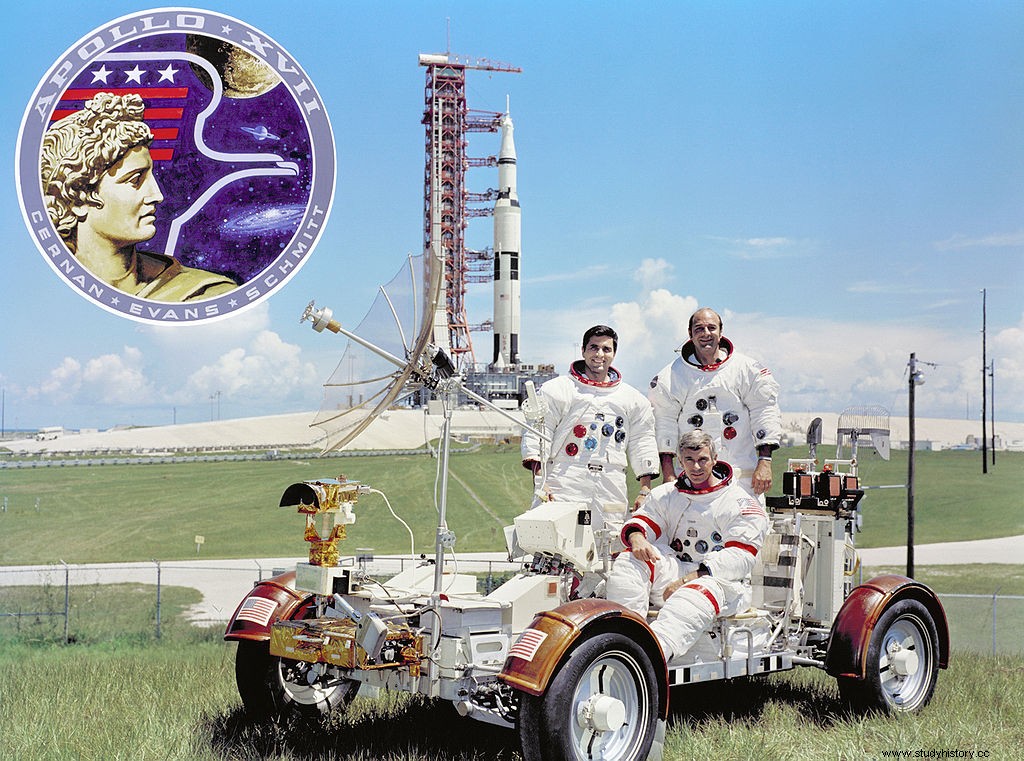
Apollo 17 mission crew before take-off - Author:NASA Source:commons.wikimedia.org
8. Bliss
Probably the longest viewed photo in the world. Well known to all computer users with the Windows system. Bliss, also known as Idylla, is an integral part of the Microsoft Windows XP operating system. Probably most people, including myself, who looked at the default Windows XP desktop background found them to be computer graphics. In fact, it is a real photo, and according to its author Charles O'Reara, it has not undergone any additional digital processing. The photograph was taken in January 1996 in California, United States. O'Reara took the photo accidentally driving to his girlfriend. There was a moment when a storm just passed, revealing green areas. At one point, the photographer saw a hill devoid of vines that usually cover these areas. So he decided to stop and take a picture. The grass was extremely green and the sun had just come out. The sky was blue, cut delicately with clouds. When taking the photo, O'Reara used the film Velvia, which gently fueled the colors. After developing the photo, the author placed it in the Corbis database as a photo made available for use, for an appropriate license fee. A few years later, it was used by Microsoft as the default background for the new Windows XP system. This is how it found its way into millions of homes around the world.

Bliss - 10 landmark photos - Author:Charles O'Rear Source:Screenshot Windows XP
9. Inmate of Abu Ghraib
It was April 28, 2004, when the American CBS station broadcast a series of cruel photos from Iraq on the program 60 Minutes II. Journalists came into possession of the photographs as a result of a leak from a military investigation. The photos, which were taken in 2003, showed torture by US military police guards at Abu Ghraib prison in Iraq. They showed mostly naked Iraqi prisoners, sometimes stacked, with their heads covered with sacks or threatened with dogs. Often in the photos they were accompanied by clearly satisfied Americans. Particularly symbolic was the image of an Iraqi standing on a cardboard box with his head covered with a pointed hood. The prisoner had his hands spread, and cables were attached to his hands. The guards told him that if he fell off the box, he would be electrocuted. The photos quickly spread around the world, were published by the main TV news, will hit the front pages of newspapers. They shocked public opinion, shook the administration of George W. Bush. Of course, this was not the first time in history that guards had mistreated prisoners. Abu Ghraib's photos coincided with the explosion in popularity of compact digital cameras. In 2003, their sales for the first time exceeded the sales of analog cameras. Since then, anyone could quickly take pictures and publish them to the whole world, for example via the Internet. Deleted photos could also be recovered from the camera's memory. Today it is an obvious situation for us. The photos were like war trophies to the rangers. They did not know, however, that they would see the light of day and thus contribute to their trial and condemnation. The hooded prisoner is Ali Shallal al-Qaisi. His picture has become a symbol of the cruelty of modern war and the violation of human rights. Photography was such a powerful image that its theme began to appear in film and art. She also contributed to the publication of Philip Zimbardo's "The Lucifer Effect", a bestseller and one of the most important books of psychology.
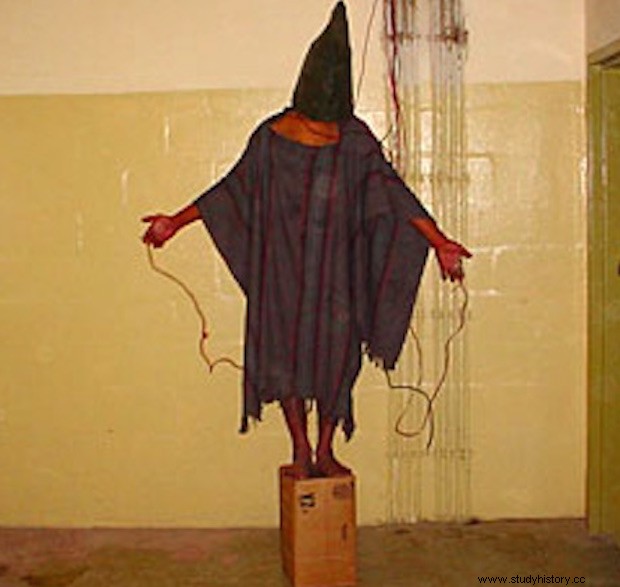
Prisoner Abu Ghraib - 10 landmark photos - Author:United States Armed Forces
10. Oscar-winning Ellen DeGeneres selfie
You are probably wondering what does such a young photo do in my comparison. In addition, a selfie photo, for some it is a symbol of kitsch and mediocrity. However, there is something extraordinary about this photo, and it is not about the accumulation of Hollywood stars in one image. This photo is, in a way, a symbol of our time. A symbol of the mobile revolution, communication via social media and the speed of information exchange via the Internet. The photo was taken at the Oscars on March 2, 2014. Ellen DeGeneres, who conducted the Oscar gala, is commonly considered the author of the photo. However, Bradley Cooper touched the shutter button. In the light of the law, he is the owner of the most popular selfie in history. And now the numbers. The photo was posted by Ellen on Twitter and within the first hour it was retweeted, i.e. retweeted, over 2 million times. Within 24 hours, that number had risen to 2.8 million. The popularity of this photo was so great that it led to an overload and suspension of the social giant for 20 minutes. Currently, the selfie has been retweeted over 3.3 million times. And we are only talking about one social network. There are countless other websites, portals, forums, media that duplicated and copied the photo. In addition, there have been various modifications called memes. I dare say that this is the fastest-spreading photo in human history. Although there are no possibilities and tools to confirm these assumptions. I personally saw this photo for the first time outside of Twitter. After the ceremony, there was also information that an Oscar-winning selfie, seemingly spontaneous, had been arranged. Specially prepared for the promotion of a certain brand of smartphone, which was ostentatiously waved by Ellen during the ceremony. Can these selfie be classified as groundbreaking photos? In my opinion, yes, but you have to judge that for yourself.
If only Bradley’s arm was longer. Best photo ever. #oscars pic.twitter.com/C9U5NOtGap
- Ellen DeGeneres (@TheEllenShow) March 3, 2014
And so we have made 10 amazing and groundbreaking photos to the end of the story. You could say that history has come full circle.
From a photo that took around the clock to take, to a photo that went around the world around the clock.
